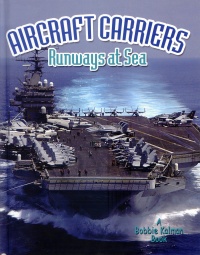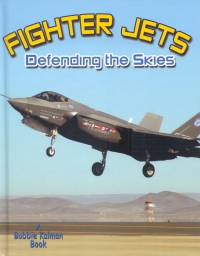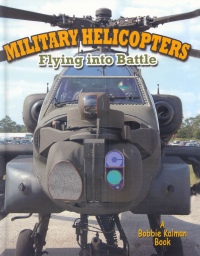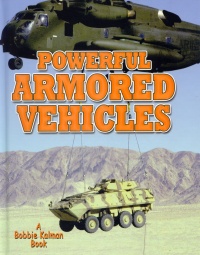| ________________
CM . . .
. Volume XIX Number 23. . . .February 15, 2013 
 |
Aircraft Carriers: Runways at Sea. (Vehicles on the Move).
Lynn Peppas.
St. Catharines, ON: Crabtree, 2012.
32 pp., pbk. & hc., $10.95 (pbk.), $20.76 (RLB.).
ISBN 978-0-7787-2752-1 (pbk.), ISBN 978-0-7787-2747-7 (RLB.).
Subject Heading:
Aircraft carriers-Juvenile literature.
Grades 2-4 / Ages 7-9.
Review by Gail Hamilton.
**½ /4
|
| |
|
 |
Fighter Jets: Defending the Skies. (Vehicles on the Move).
Lynn Peppas.
St. Catharines, ON: Crabtree, 2012.
32 pp., pbk. & hc., $10.95 (pbk.), $20.76 (RLB.).
ISBN 978-0-7787-2753-8 (pbk.), ISBN 978-0-7787-2748-4 (RLB.).
Subject Heading:
Jet fighter planes-Juvenile literature.
Grades 2-4 / Ages 7-9.
Review by Gail Hamilton.
**½ /4
|
| |
|
 |
Military Helicopters: Flying into Battle. (Vehicles on the Move).
Lynn Peppas.
St. Catharines, ON: Crabtree, 2012.
32 pp., pbk. & hc., $10.95 (pbk.), $20.76 (RLB.).
ISBN 978-0-7787-2754-5 (pbk.), ISBN 978-0-7787-2749-1 (RLB.).
Subject Headins:
Military helicopters-Juvenile literature.
Grades 2-4 / Ages 7-9.
Review by Gail Hamilton.
**½ /4
|
| |
|
 |
Powerful Armored Vehicles. (Vehicles on the Move).
Lynn Peppas.
St. Catharines, ON: Crabtree, 2012.
32 pp., pbk. & hc., $10.95 (pbk.), $20.76 (RLB.).
ISBN 978-0-7787-275502 (pbk.), ISBN 978-0-7787-2750-7 (RLB.).
Subject Heading:
Armored vehicles, Military-Juvenile literature.
Grades 2-4 / Ages 7-9.
Review by Gail Hamilton.
**½ /4
|
| |
|

excerpt:
The driver sits inside the hull, or lower body, of the tank underneath the main gun. He or she sees outside by looking through a periscope. Periscopes show what is going on around the tank on the outside. Night vision equipment is used by drivers to see at night without using lights. This way the enemy won't spot them. The equipment "sees" things by the heat they give off. The turret is a structure for weapons on top of the hull. It can move in a complete circle. The main gun and machine guns are on the turret and can be aimed in any direction. (From Powerful Armored Vehicles.)
Part of the 20-volume "Vehicles on the Move" series, these books provide fairly simple explanations about how different military vehicles work. Within each category of vehicle, there are many variants, and these are showcased in double-page spreads. There are two paragraphs describing each type of vehicle and plenty of colour photographs and diagrams to enhance the text. Boys, particularly those who are fascinated by topics related to the U.S. military, will be drawn to these books. Though the text is quite age-appropriate for the most part and is printed in a large, simple font, the nature of the topic lends itself to a slightly older audience. And, although Canadian readers might still enjoy reading about military vehicles, none of the examples are Canadian. Colour photographs, taken from various vantage points, comprise the illustrations, and they steal the show. A table of contents, a glossary and an index are provided.
Of these four new titles in the series, perhaps the most interesting one is Aircraft Carriers: Runways at Sea. An aircraft carrier is a huge military ship (some carriers are as long as four and a half football fields) that serves two purposes: it acts as a runway for jet aircraft and also serves as an airbase. It is one of the most expensive military vehicles, with costs running to the billions of dollars. Large carriers could have more than 5000 people on board. Deck personnel wear different coloured shirts to indicate the various jobs that they perform. For example, yellow shirts are for those who handle aircraft that are taking off and landing; captains wear brown; purple shirts belong to the people who fuel the aircraft; and white is for the safety crew. In this title, readers will learn about different types of carriers, ranging from the most important fleet carriers which carry attack aircraft, to light aircraft carriers which carry helicopters, and anti-submarine warfare carriers which are used to find and destroy enemy submarines. Readers will also find interesting the way in which a pilot lands on an aircraft carrier. A tailhook, located at the back of the tail, catches onto a steel cable called an arresting wire. This helps the jet to stop in seconds.
Fighter Jets: Defending the Skies showcases several types of aircraft. Small and swift, fighter jets spy, attack enemy aircraft and ground forces, and drop bombs or missiles. Some of the topics in this title include fighter pilot gear, how fighter jets fly, and the parts of a fighter jet. There is also a very basic explanation of G-force and how pilots overcome it. The majority of the book, however, is devoted to specific fighter jets, including the Phantom II, a supersonic jet that can fly faster than the speed of sound and is capable of firing over 6000 rounds or shots per minute; the Harrier, which can take off and land straight up and down; and, at a cost of $55 million, the Super Hornet which can get refuelled, or can refuel another jet in mid-air; plus the fighting Falcon, a dogfighter which can travel at twice the speed of sound and is equipped with a Night Vision Imaging System. Various types of stealth aircraft are also featured in this title.
Protected by armour, military helicopters perform several tasks which include monitoring areas, moving soldiers and weapons, attacking enemy targets on land and at sea, and conducting search and rescue missions. Military Helicopters: Flying into Battle highlights several different types of choppers: scout helicopters that are used for observation; transport, or cargo, helicopters, such as the Super Stallion, that can move people and very heavy equipment; and the Chinook, which can land on the ground and on water; anti-submarine helicopters which locate subs as well as underwater mines; and attack helicopters which carry guns, rockets and missiles. There is also information about a "hybrid" type vehicle called a tiltrotor aircraft. The tiltrotor has wings like an airplane, but it can move vertically and hover like a helicopter, and it can fly much faster than a helicopter. Also featured in this title is information about a pilot's flight suit, the cockpit, and the "workhorse" of the U. S. Army, the Black Hawk. This helicopter, manned by two pilots, carries heavy loads as well as machine guns.
Finally, Powerful Armored Vehicles discusses the vehicles employed in ground warfare- tanks, amphibious vehicles, personnel carriers, surveillance vehicles, unmanned vehicles and ATVs. Due to their use in combat, these machines are protected by armor which can be made out of steel, ceramic, or a combination of both, and they are usually camouflaged to avoid easy detection by the enemy. Each vehicle has its own specific use and specialized parts for navigating various types of terrain. Battle tanks, usually with a crew of four, are the most heavily armored and travel slowly on tracks. They are found on the front lines during battle, and some of them have equipment that is capable of detecting guided missiles coming toward them and jamming the missile's signal so that the missile strays off course. Other armored vehicles run on wheels rather than tracks. They can carry larger groups of soldiers with rocket launchers into battle. The Namer, one of the best protected personnel carriers, has an air filter which screens out nuclear, biological and chemical toxins, while the Coyote boasts a sophisticated electronic surveillance system, and the Oshkosh M-ATV has tires that can travel several miles after being pierced without going flat. Lastly, unmanned vehicles, controlled by a commander in another tank, can gather information about the enemy and can go into dangerous areas with supplies and weapons.
Requiring a little more of the reader than the other books in the series, these titles will appeal to young males nevertheless.
Recommended.
Gail Hamilton is a former teacher-librarian in Winnipeg, MB.

To comment
on this title or this review, send mail to cm@umanitoba.ca.
Copyright © the Manitoba Library Association. Reproduction for personal
use is permitted only if this copyright notice is maintained. Any
other reproduction is prohibited without permission.
NEXT REVIEW |
TABLE OF CONTENTS FOR THIS ISSUE
- February 15, 2013.
AUTHORS |
TITLES |
MEDIA REVIEWS |
PROFILES |
BACK ISSUES |
SEARCH |
CMARCHIVE |
HOME |



